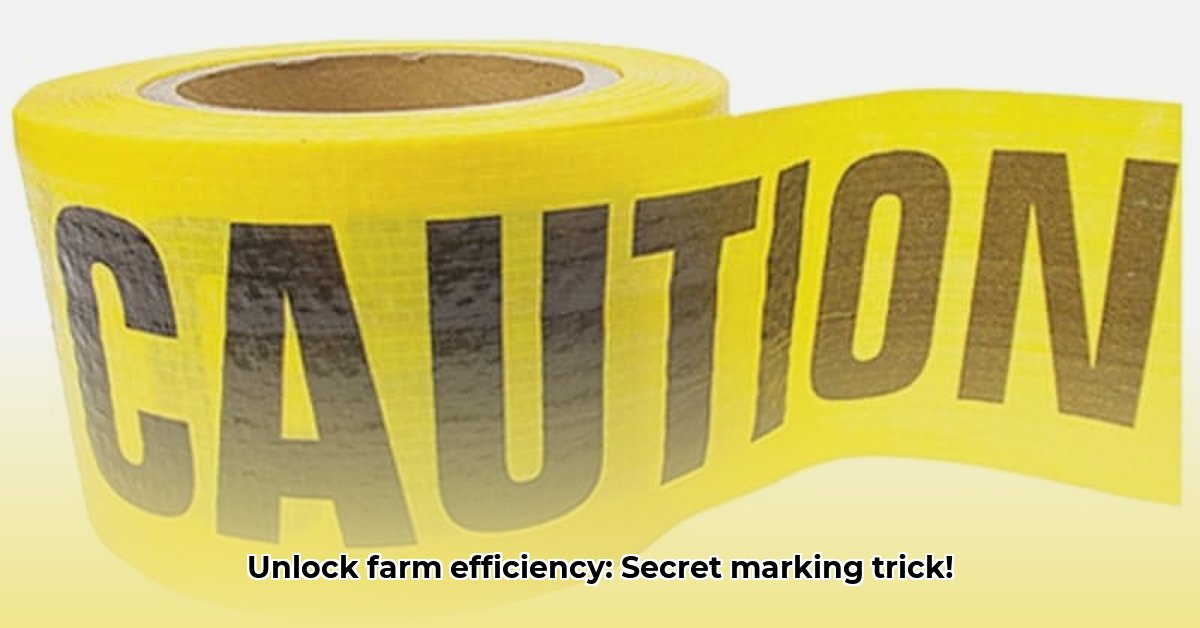
Farming demands precision and efficiency. Every decision, from planting to harvest, impacts yield and profitability. Tractor Supply marking flags are surprisingly effective tools that can significantly enhance your farming operations, leading to higher yields and reduced waste. For more information on Tractor Supply products, check out their website. This guide explores the various types of flags available, provides practical applications across several farming practices, and offers best practices for maximizing their impact.
Exploring Tractor Supply's Marking Flag Options
Tractor Supply offers a range of marking flags to suit diverse farming needs. The flags differ in material, durability, visibility, and size. Choosing the right flag type is crucial for optimal performance and longevity.
Standard Duty Marking Flags: These are your everyday flags, typically made from durable nylon in various colors. Ideal for general marking tasks where durability is less critical.
Heavy-Duty Marking Flags: Constructed from reinforced materials, these flags are designed to withstand harsh weather conditions and rough handling. Their superior durability justifies the slightly higher cost with reduced replacements.
High-Visibility Marking Flags: Safety is paramount, particularly around roads or in low-light conditions. These flags utilize fluorescent colors for exceptional visibility, improving safety and preventing accidents.
Specialty Marking Flags: Tractor Supply might offer flags with additional features like reflective strips for nighttime visibility or biodegradable materials for eco-conscious farmers. Always check their current offerings for the most up-to-date selection. Isn't it interesting how a simple flag can contribute to enhanced safety and environmental responsibility?
Strategic Applications of Marking Flags in Sustainable Agriculture
Marking flags aren't just colorful markers; they're integral tools for efficient resource management and optimized farming practices.
Precision Farming: Optimizing Resource Allocation
Precision farming maximizes yields while minimizing waste. Marking flags enable efficient resource management in several ways.
- Defining Field Boundaries: Clearly define field boundaries for precise application of fertilizers, pesticides, and herbicides, preventing over-application and reducing environmental impact. Are you maximizing the effectiveness of each application?
- Irrigation Zone Management: Delimitate irrigation zones based on soil type and crop needs for optimized water use. Preventing overwatering in some areas while underwatering others ensures uniform growth and reduces water waste. Have you considered the potential savings from reducing water waste?
- Targeted Treatments: Flag specific areas needing specialized treatment, such as those requiring additional fertilizer or pest management. This approach improves efficiency and reduces resource consumption. How much could you save on inputs by only treating the areas that need it?
Crop Monitoring and Disease Management
Early detection of crop diseases or stress is vital. Marking flags help in this critical process:
- Identifying Problematic Plants: Mark individual plants showing signs of disease or stress for quick identification and treatment before the problem spreads. This targeted approach minimizes crop loss and maximizes yields. Does early intervention save your yields?
- Yield Assessment: Label plants showing superior growth for later yield assessment. By studying the most successful plants, you can optimize your future farming practices. What's the return on investment of improved crop selection?
- Tracking Growth: Mark plants at various growth stages to track their progress and make informed decisions regarding water, fertilization, and harvesting, all contributing to enhanced yields. How much does precise tracking contribute to your farm's profitability?
Soil Health Management
Maintaining soil health is key to long-term farm productivity. Marking flags assist in:
- Identifying Soil Types: Delimitate areas with different soil types or conditions which might require alternate farming practices. Precise treatment maximizes yield for each soil type. What are the long-term benefits of managing your soils effectively?
- Targeted Soil Amendments: Mark areas requiring specific soil amendments for optimized nutrient levels, again promoting consistent growth and yield. How much does understanding your soils improve overall productivity?
Livestock Management Enhancement
Efficient livestock management is crucial for profitability. Marking flags assist in:
- Defining Grazing Areas: Clearly delineate grazing zones to prevent overgrazing and ensure uniform pasture usage. This improves pasture health and animal wellbeing. What's the value of rotating grazing pastures effectively?
- Identifying Problem Spots: Mark areas where livestock require special attention, such as water sources or areas with potential hazards. Clear identification prevents injuries. Does careful planning reduce veterinary costs?
Best Practices for Using Marking Flags
Effective flag placement and maintenance are key for optimal results:
- Strategic Placement: Ensure flags are easily visible from multiple angles for clear identification and planning. Consider the vantage points of both workers and machinery.
- Durable Flag Selection: Choose flags appropriate for your climate and usage intensity to minimize replacements. High-quality flags are a worthwhile investment in long-term efficiency.
- Regular Inspection: Regularly check flags for damage or fading, replacing them promptly to maintain accurate markings. How important is preserving marker visibility for efficiency?
- Responsible Disposal: Dispose of old flags correctly to avoid environmental pollution. What is your strategy for sustainable farming practices?
Conclusion: The Power of a Simple Marking Flag
Tractor Supply marking flags are more than just colorful markers; they're versatile, time-saving, and resource-optimizing tools every farmer should utilize. By implementing the strategies and best practices outlined, you can significantly improve your farming operations, reduce waste, and boost both yields and profitability. The small cost of these flags is significantly outweighed by the improved efficiency and sustainable farming practices they enable.